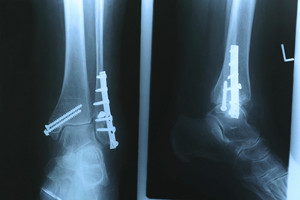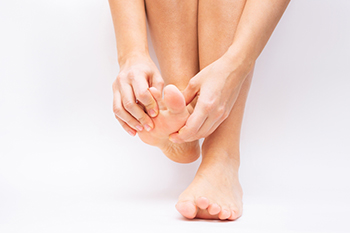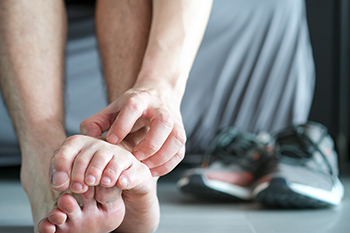Connect With Us
Blog
Items filtered by date: August 2022
Proper Wound Care for Diabetic Patients

Treating wounds on the feet correctly is essential in maintaining proper foot health. Many diabetic patients with foot wounds may not be aware of them due to having neuropathy. This is defined as having damaged nerve endings from elevated blood sugar levels and it can be difficult to feel existing cuts, scrapes, or bruises on the feet. A simple wound may turn into a foot ulcer which can gradually lead to gangrene or amputation if prompt medical treatment is not received. It is suggested that diabetic patients check their feet daily for any abnormalities that may have developed, and this can be done by using a mirror or by having a family member check the soles of the feet. An existing wound is best treated by gently cleaning it with warm water, followed by covering it with a sterile bandage or dressing. If you have diabetes and develop wounds on the feet, it is strongly advised that you are under the care of a podiatrist who can help you manage this condition.
Wound care is an important part in dealing with diabetes. If you have diabetes and a foot wound or would like more information about wound care for diabetics, consult with Joan Oloff, DPM from Los Gatos Foot and Ankle . Our doctor will assess your condition and provide you with quality foot and ankle treatment.
What Is Wound Care?
Wound care is the practice of taking proper care of a wound. This can range from the smallest to the largest of wounds. While everyone can benefit from proper wound care, it is much more important for diabetics. Diabetics often suffer from poor blood circulation which causes wounds to heal much slower than they would in a non-diabetic.
What Is the Importance of Wound Care?
While it may not seem apparent with small ulcers on the foot, for diabetics, any size ulcer can become infected. Diabetics often also suffer from neuropathy, or nerve loss. This means they might not even feel when they have an ulcer on their foot. If the wound becomes severely infected, amputation may be necessary. Therefore, it is of the upmost importance to properly care for any and all foot wounds.
How to Care for Wounds
The best way to care for foot wounds is to prevent them. For diabetics, this means daily inspections of the feet for any signs of abnormalities or ulcers. It is also recommended to see a podiatrist several times a year for a foot inspection. If you do have an ulcer, run the wound under water to clear dirt from the wound; then apply antibiotic ointment to the wound and cover with a bandage. Bandages should be changed daily and keeping pressure off the wound is smart. It is advised to see a podiatrist, who can keep an eye on it.
If you have any questions, please feel free to contact our office located in Los Gatos, CA . We offer the newest diagnostic and treatment technologies for all your foot care needs.
It's Time for Beautiful Feet
What Causes a Tailor’s Bunion?

A tailor’s bunion is defined as a swollen lump that forms on the side of the pinky toe. It is smaller than a normal bunion possibly because of the area it develops in. It can be referred to as a bunionette and can result in the bottom bone of the little toe shifting outward. This bone is called the fifth metatarsal bone and in addition to shifting it may become enlarged. A common cause of a tailor’s bunion is wearing shoes that are too narrow and this may be prevalent among women who frequently wear high heels. People who have an abnormal foot structure may notice this type of bunion also, which may be inherited. Additional reasons can include having loose ligaments in the foot and tight calf muscles. Many patients choose to wear custom-made orthotics that can help to diminish existing pain while cushioning the bunion. If you have developed a tailor’s bunion, it is suggested that you speak with a podiatrist who can determine what the best course of treatment is for you.
If you are suffering from bunion pain, contact Joan Oloff, DPM of Los Gatos Foot and Ankle . Our doctor can provide the care you need to keep you pain-free and on your feet.
What Is a Bunion?
Bunions are painful bony bumps that usually develop on the inside of the foot at the joint of the big toe. As the deformity increases over time, it may become painful to walk and wear shoes. Women are more likely to exacerbate existing bunions since they often wear tight, narrow shoes that shift their toes together. Bunion pain can be relieved by wearing wider shoes with enough room for the toes.
Causes
- Genetics – some people inherit feet that are more prone to bunion development
- Inflammatory Conditions - rheumatoid arthritis and polio may cause bunion development
Symptoms
- Redness and inflammation
- Pain and tenderness
- Callus or corns on the bump
- Restricted motion in the big toe
In order to diagnose your bunion, your podiatrist may ask about your medical history, symptoms, and general health. Your doctor might also order an x-ray to take a closer look at your feet. Nonsurgical treatment options include orthotics, padding, icing, changes in footwear, and medication. If nonsurgical treatments don’t alleviate your bunion pain, surgery may be necessary.
If you have any questions, please feel free to contact our office located in Los Gatos, CA . We offer the newest diagnostic and treatment technologies for all your foot care needs.
What Is a Stress Fracture?

A stress fracture is caused by a bone being subjected to repeated actions, which can cause serious injury to the bone over time. Stress fractures are common in the feet and ankles. With repetitive foot actions, particularly common among athletes, the body is unable to send enough calcium to the stressed bone, and cracks might develop in the bone over time. Stress fractures might be hard to notice at first because they occur gradually, but one might notice chronic pain or night aches that do not go away after rest. The area affected might feel tender, weak, numb, and become bruised or swollen. It look deformed in some way at the site of the stress fracture, and it be hard to bear weight or move normally. If you feel this type of pain in your foot or ankle, especially if you feel a tingling or pins and needles feeling at the site of injury, see a podiatrist who can properly diagnose the problem and provide appropriate treatment.
Stress fractures occur when there is a tiny crack within a bone. To learn more, contact Joan Oloff, DPM from Los Gatos Foot and Ankle . Our doctor can provide the care you need to keep you pain free and on your feet.
How Are They Caused?
Stress fractures are the result of repetitive force being placed on the bone. Since the lower leg and feet often carry most of the body’s weight, stress fractures are likely to occur in these areas. If you rush into a new exercise, you are more likely to develop a stress fracture since you are starting too much, too soon. Pain resulting from stress fractures may go unnoticed at first, however it may start to worsen over time.
Risk Factors
- Gender – They are more commonly found in women compared to men.
- Foot Problems – People with unusual arches in their feet are more likely to develop stress fractures.
- Certain Sports – Dancers, gymnasts, tennis players, runners, and basketball players are more likely to develop stress fractures.
- Lack of Nutrients – A lack of vitamin D and calcium may weaken the bones and make you more prone to stress fractures
- Weak Bones – Osteoporosis can weaken the bones therefore resulting in stress fractures
Stress fractures do not always heal properly, so it is important that you seek help from a podiatrist if you suspect you may have one. Ignoring your stress fracture may cause it to worsen, and you may develop chronic pain as well as additional fractures.
If you have any questions, please feel free to contact our office located in Los Gatos, CA . We offer the newest diagnostic and treatment technologies for all your foot care needs.
Toe Lesions

Individuals may experience pain in the toes for a multitude of different reasons. For example, toe pain may arise from problems in the bones or calluses that formed on the outside of the toes. One condition that can cause toe pain is known as lesions. These can develop on more than one toe, and sometimes on both feet. Lesions can cause pain during the day and create an extremely uncomfortable itching sensation throughout the night. Another important sign of lesions on the toes is swelling around the affected area and discoloration, which can essentially turn the toe into a purple tint. What can make toe lesions all the more troubling and uncomfortable is that wearing anything on the feet, from socks to shoes, can be extremely painful. Chilblains, a related condition, usually develop on the feet when blood vessels become inflamed as a result of exposure to cold temperatures. Some cases of toe lesions have also been identified in individuals who have tested positive for COVID-19, although any kind of definitive, causal relationship between the two conditions remains to be seen. If you think that you are suffering from toe lesions, consider reaching out to a podiatrist.
Toe pain can disrupt your daily activities. If you have any concerns, contact Joan Oloff, DPM of Los Gatos Foot and Ankle . Our doctor can provide the care you need to keep you pain-free and on your feet.
What Causes Toe Pain?
Most severe toe pain is caused due to a sports injury, trauma from dropping something heavy on the toe, or bumping into something rigid. Other problems can develop over time for various reasons.
Toe pain can be caused by one or more ailments. The most common include:
- Trauma
- Sports injury
- Wearing shoes that are too tight
- Arthritis
- Gout
- Corns and calluses
- Hammertoe
- Bunions
- Blisters
- Ingrown toenails
- Sprains
- Fractures (broken bones)
- Dislocations
When to See a Podiatrist
- Severe pain
- Persistent pain that lasts more than a week
- Signs of infection
- Continued swelling
- Pain that prevents walking
Diagnosis
In many cases the cause of toe pain is obvious, but in others, a podiatrist may want to use more advanced methods to determine the problem. These can range from simple visual inspections and sensation tests to X-rays and MRI scans. Prior medical history, family medical history, and any recent physical traumatic events will all be taken into consideration for a proper diagnosis.
Treatment
Treatments for toe pain and injuries vary and may include shoe inserts, padding, taping, medicines, injections, and in some cases, surgery. If you believe that you have broken a toe, please see a podiatrist as soon as possible.
If you have any questions please feel free to contact our office located in Los Gatos, CA . We offer the newest diagnostic tools and technology to treat your foot and ankle needs.
Parts of the Foot Affected by Athlete’s Foot

A common foot infection is known as athlete’s foot. Its medical term is tinea pedis, and it is caused by a fungus. This type of fungus lives and thrives in warm and moist environments, including public shower room floors, and locker rooms. It is beneficial to wear appropriate shoes while in these types of areas, and to refrain from sharing socks, shoes, and towels. Common symptoms that are associated with athlete’s foot consist of itchy feet, the soles may turn red and become dry, and the skin may crack between the toes. A proper diagnosis can include having a podiatrist examine the feet, often followed by having a sample taken of infected skin. Many times medication is prescribed that can provide mild relief for the itching and scaling. Effective prevention methods include washing and drying the feet daily, followed by wearing a clean pair of socks, and alternating the shoes that are worn. Additionally, it is beneficial to wear shoes that are made of breathable materials and to avoid wearing shoes made of vinyl. If you have questions about relief for athlete’s foot, please confer with a podiatrist who can determine what the best course of treatment is for you.
Athlete’s foot is an inconvenient condition that can be easily reduced with the proper treatment. If you have any concerns about your feet and ankles, contact Joan Oloff, DPM from Los Gatos Foot and Ankle . Our doctor will treat your foot and ankle needs.
Athlete’s Foot: The Sole Story
Athlete's foot, also known as tinea pedis, can be an extremely contagious foot infection. It is commonly contracted in public changing areas and bathrooms, dormitory style living quarters, around locker rooms and public swimming pools, or anywhere your feet often come into contact with other people.
Solutions to Combat Athlete’s Foot
- Hydrate your feet by using lotion
- Exfoliate
- Buff off nails
- Use of anti-fungal products
- Examine your feet and visit your doctor if any suspicious blisters or cuts develop
Athlete’s foot can cause many irritating symptoms such as dry and flaking skin, itching, and redness. Some more severe symptoms can include bleeding and cracked skin, intense itching and burning, and even pain when walking. In the worst cases, Athlete’s foot can cause blistering as well. Speak to your podiatrist for a better understanding of the different causes of Athlete’s foot, as well as help in determining which treatment options are best for you.
If you have any questions please feel free to contact our office located in Los Gatos, CA . We offer the newest diagnostic and treatment technologies for all your foot and ankle needs.

